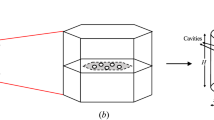Abstract
Under the assumption that the processes which control the direction of crack growth in 2024-T3 aluminum are directly related to void initiation and growth, a theoretical framework is developed to predict the direction of crack growth. The basic premise of the framework is that, depending on the mode mixity of the remotely applied loading, either σ m /σeff or σeff triggers the nucleation and growth of voids hence, fracture. The theoretical development uses linear elastic assumptions and two terms in the asymptotic expansion to describe the stress field in the vicinity of the crack tip for a mixed-mode I/II ARCAN specimen. Predictions based on the theory indicate that: (a) the transition from Mode~I type to Mode~II type crack propagation can be accurately quantified, and (b) the direction of crack growth is reasonably well predicted for both types of crack propagation. In addition, a qualitative, but microstructurally based, physical rationale for the observed phenomena is presented.
Similar content being viewed by others
References
J.M. Koo, and Y.S. Choy, A new mixed-mode fracture criterion: maximum tangential strain energy density criterion. Engineering Fracture of Mechanics 39(3), (1991) 443–449.
E.H. Yoffe, The moving Griffith crack. Philosophical Magazine 42 (1951) 739–750.
I. Finnie, and A. Saith, A note on the angled crack problem and the directional stability of cracks. International Journal of Fracture 9 (1973) 484–486.
P. Pawliska, H.A. Richard, and P. Kiekmann, The behavior of cracks in elastic-plastic materials under plane normal and shear loadings. International Journal of Fracture 62 (1993) 43–54.
B. Cotterell, and J.R. Rice, Slightly curved or kinked cracks. International Journal of Fracture 16 (1980) 155–169.
Y. Sumi, Y. Nemat-Nasser, and L.M. Keer, On crack path stability in a finite body. Engineering Fracture of Mechanics 22 (1985) 759–771.
G.C. Sih, Strain energy-density factor applied to mixed mode crack problem. International Journal of Fracture 10 (1974) 305–321.
M. Ramulu, and A.S. Kobayashi, Dynamic crack curving — A photoelastic evaluation. Experience Mechanics 23, (1983) 1–9.
C.H. Wu, Fracture under combined loads by maximum energy release rate criterion. Journal of Applied Mechanics 45 (1978) 553–558.
B.E. Amstutz, M.A. Sutton, D.S. Dawicke and J.C. Newman, Jr., An experimental study of CTOD for mode I/mode II stable crack growth in thin 2024-T3 aluminum specimens. ASTM STP 1256 on Fracture Mechanics (1995) 256–271.
B.E. Amstutz, M.A. Sutton, D.S. Dawicke and M.L. Boone, Effects of mixed mode I/II loading and grain orientation on crack initiation and stable tearing in 2024-T3 aluminum. ASTM STP 1296 on Fatigue and Fracture, in press.
N. Hallback, N. and F. Nilsson, Mixed mode I/II fracture behaviour of an aluminium alloy. Journal of Mechanical Physics Solids 42(9) (1994) 1345–1374.
J.R. Rice, The localization of plastic deformation. Theoretical and Applied Mechanics 14th IUTAM Congress (Edited by W. Koiter), (1976) 207–220.
J.W. Rudnicki and J.R. Rice, Conditions for the localization of deformation in pressure-sensitive dilatant materials. Journal of Mechanical Physics Solids 23 (1975) 371–394.
R.O. Ritchie and A.W. Thompson, On macroscopic and microscopic analyses for crack initiation and crack growth in ductile alloys. Metallurgical Transfer A 16A (1985) 233–248.
S.H. Goods and L.M. Brown, The nucleation of cavities by plastic deformation. Acta Metallurgica 27 (1979) 1–15.
J.E. Hatch, Aluminum: Properties and Physical Metallurgy, American Society for Metals, Metals Park, Ohio (1988).
V. Gerold and E. Bubeck, Small angle scattering experiments from Al-4wt.% Cu single crystals containing G. P. I zones. Scripta Metallurgica 22 (1988) 953–958.
V. Gerold and H. Karnthaler, On the origin of planar slip in FCC alloys. Acta Metallurgica 37(8) (1989) 2177–2183.
D.S. Dawicke and M.A. Sutton, CTOA and crack tunneling measurements in thin sheet 2024-T3 aluminum alloy. Experience Mechanics 34(4) (1996) 357–368.
M.L. Williams, On the stress distribution at the base of a stationary crack. Journal of Applied Mechanics 24 (1957) 109–114.
P.W. Wawrzynek and A.R. Ingraffea, Interactive finite element analysis of fracture processes: An integrated approach. Theoretical and Applied Mechanics 8 (1987) 137–150.
R.D. Henshell and K.G. Shaw, Crack tip finite elements are unnecessary. International Journal of Numerical Methods in Engineering 12 (1975) 93–99.
J.C. Newman, Jr., Finite element analysis of fatigue crack propagation including the effects of crack closure, Ph.D. Thesis, VPI&SU in Blacksburg, VA (1974).
P.S. Leevers and J.C. Radon, Inherent stress biaxiality in various fracture specimen geometries. International Journal of Fracture 19 (1982) 311–325.
A.P. Kfouri, Some evaluations of the elastic T-term using Eshelby's method. International Journal of Fracture 30 (1986) 301–315.
P.F. Thomason, A model of dynamic fracture-toughness under conditions of nucleation-controlled ductile fracture. Acta Metallurgica et Matematica 40(2) (1992) 241–249.
J.R. Rice and D.M. Tracey, On the ductile enlargement of voids in triaxial stress fields. Journal of Mechanical Physics Solids 17 (1969) 201–207.
A.L. Gurson, Continuum theory of ductile rupture by void nucleation and growth: Part I — Yield criteria and flow rules for porous ductile media. Journal of Engineering Materials and Technology 99 (1977) 2–15.
P.F. Thomason, Ductile Fracture of Metals, Pergamon Press (1990).
S. Yang, Y.J. Chao and M.A. Sutton, Complete theoretical analysis of higher order asymptotic terms and the HRR zone at a crack tip for mode I and mode II loading of a hardening material. Acta Mechanica 98 (1993) 79–98.
S. Yang, Y.J. Chao and M.A. Sutton, Higher order asymptotic crack tip fields in a power law hardening material. Engineering Fracture of Mechanics 45(1) (1993) 1–20.
Y.J. Chao, S. Yang and M.A. Sutton, On the fracture of solids characterized by one or two parameters: Theory and practice. Journal of Mechanical Physics Solids 42(4) (1994) 629–647.
Y.J. Chao and W. Ji, Cleavage fracture quantified by J and A 2. ASTM STP 1244 on Constraint Effects in Fracture (1995).
Author information
Authors and Affiliations
Rights and permissions
About this article
Cite this article
Sutton, M., Zhao, W., Boone, M. et al. Prediction of crack growth direction for mode I/II loading using small-scale yielding and void initiation/growth concepts. International Journal of Fracture 83, 275–290 (1997). https://doi.org/10.1023/A:1007339625267
Issue Date:
DOI: https://doi.org/10.1023/A:1007339625267




